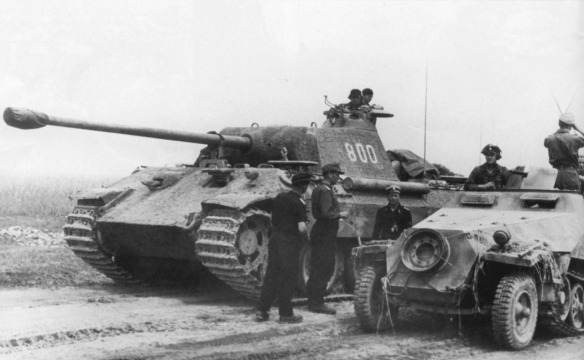SS-Obersturmführer Karl Nicolussi-Leck (Panther’s cupola), commander of 8./SS-Panzerregiment 5 of the Wiking Division, and a Sd.Kfz. 251/3 Ausf. D, during the battles east of Warsaw, August 1944. Between August 18-22, IV.SS-Panzer-Korps, comprising the Totenkopf and the Wiking Division, destroyed 98 Soviet tanks destroyed in the battles around Warsaw.
Soviet (1st Belorussian Front’s) Actions East of Warsaw in August-September 1944.
No Eastern Front action has generated more heated controversy then Soviet operations east of Warsaw in August and September 1944, at the time of the Warsaw Uprising against the Nazis by the Polish Home Army. Western historians have routinely blamed the Soviets for deliberately failing to assist the Poles, and in essence, aiding and abetting destruction of the Polish rebels by the German Army for political reasons. Soviet historians have countered that every attempt was made to provide assistance but that operational considerations precluded such help. No complete single Soviet volume exists which recounts in detail these operations on the approaches to Warsaw. The historian is forced to reconstruct events by referring to a host of fragmentary sources. Ironically, German archival materials, in particular Second Army records and other materials (and probably the records of Ninth Army, captured by the Soviets and unavailable to Western historians), help to justify the Soviet argument.
Operational details about Soviet combat on the approaches to Warsaw can be reconstructed from fragmentary Soviet and German archival sources (see map 15). On 28 July 1994, Maj. Gen. A. I. Radzievsky’s 2d Tank Army, which had been turned north from the Magnuszew region to strike at Warsaw, with three corps abreast, engaged German 73d Infantry Division and the Hermann Goering Parachute Panzer Division 40 kilometers southeast of Warsaw. A race ensued between Radzievsky, who was seeking to seize the routes into Warsaw from the east, and the Germans, who were attempting to keep these routes open and maintain possession of Warsaw. The nearest Soviet forces within supporting range of Radzievsky were 47th Army and 11th Tank and 2d Guards Cavalry Corps, then fighting for possession of Seidlce, 50 kilometers to the east. On 29 July Radzievsky dispatched his 8th Guards and 3d Tank Corps northward in an attempt to swing northeast of Warsaw and turn the German defender’s left flank, while his 16th Tank Corps continued to fight on the southeastern approaches to the city’s suburbs.
Although 8th Guards Tank Corps successfully fought to within 20 kilometers east of the city, 3d Tank Corps ran into a series of successive panzer counterattacks orchestrated by Field Marshal W. Model, new commander of Army Group Center. Beginning on 30 July, the Hermann Goering and 19th Panzer Divisions struck the overextended and weakened tank corps north of Wolomin, 15 kilometers northeast of Warsaw. Although the corps withstood three days of counterattacks, on 2 and 3 August, 4th Panzer Division and SS Panzer Division Viking joined the fight. In three days of intense fighting, 3d Tank Corps was severely mauled, and 8th Guards Tank Corps was also severely pressed. By 5 August 47th Army forces had arrived in the region, and 2d Tank Army was withdrawn for rest and refitting. The three rifle corps of 47th Army were now stretched out along a front of 80 kilometers from south of Warsaw to Seidlce and were unable to renew the drive on Warsaw or to the Narew River. German communications lines eastward to Army Group Center, then fighting for its life north and west of Brest, had been damaged but not severed.
Meanwhile, on 1 August the Polish Home Army had launched an insurrection in the city. Although they seized large areas in downtown Warsaw, the insurgents failed to secure the four bridges over the Vistula and were unable to hold the eastern suburbs of the city (Praga). During the ensuing weeks, while the Warsaw uprising progressed and ultimately failed, the Soviets continued their drive against Army Group Center northeast of Warsaw. For whatever motive, 1st Belorussian Front focused on holding firmly to the Magnuszew bridgehead, which was subjected to heavy German counterattacks throughout mid-August, and on driving forward across the Bug River to seize crossings over the Narew River necessary to facilitate future offensive operations. Soviet 47th Army remained the only major force opposite Warsaw until 20 August, when it was joined by 1st Polish Army. Soviet forces finally broke out across the Bug River on 3 September, closed up to the Narew River the following day, and fought their way into bridgeheads across the Narew on 6 September. On 13 September lead elements of two Polish divisions assaulted across the Vistula River into Warsaw but made little progress and were evacuated back across the river on 23 September.
Political considerations and motivations aside, an objective consideration of combat in the region indicates that, prior to early September, German resistance was sufficient to halt any Soviet assistance to the Poles in Warsaw, were it intended. Thereafter, it would have required a major reorientation of military efforts from Magnuszew in the south or, more realistically, from the Bug and Narew River axis in the north in order to muster sufficient force to break into Warsaw. And once broken into, Warsaw would have been a costly city to clear of Germans and an unsuitable location from which to launch a new offensive.
This skeletal portrayal of events outside of Warsaw demonstrates that much more needs to be revealed and written about these operations. It is certain that additional German sources exist upon which to base an expanded account. It is equally certain that extensive documentation remains in Soviet archival holdings. Release and use of this information can help answer and lay to rest this burning historical controversy.
